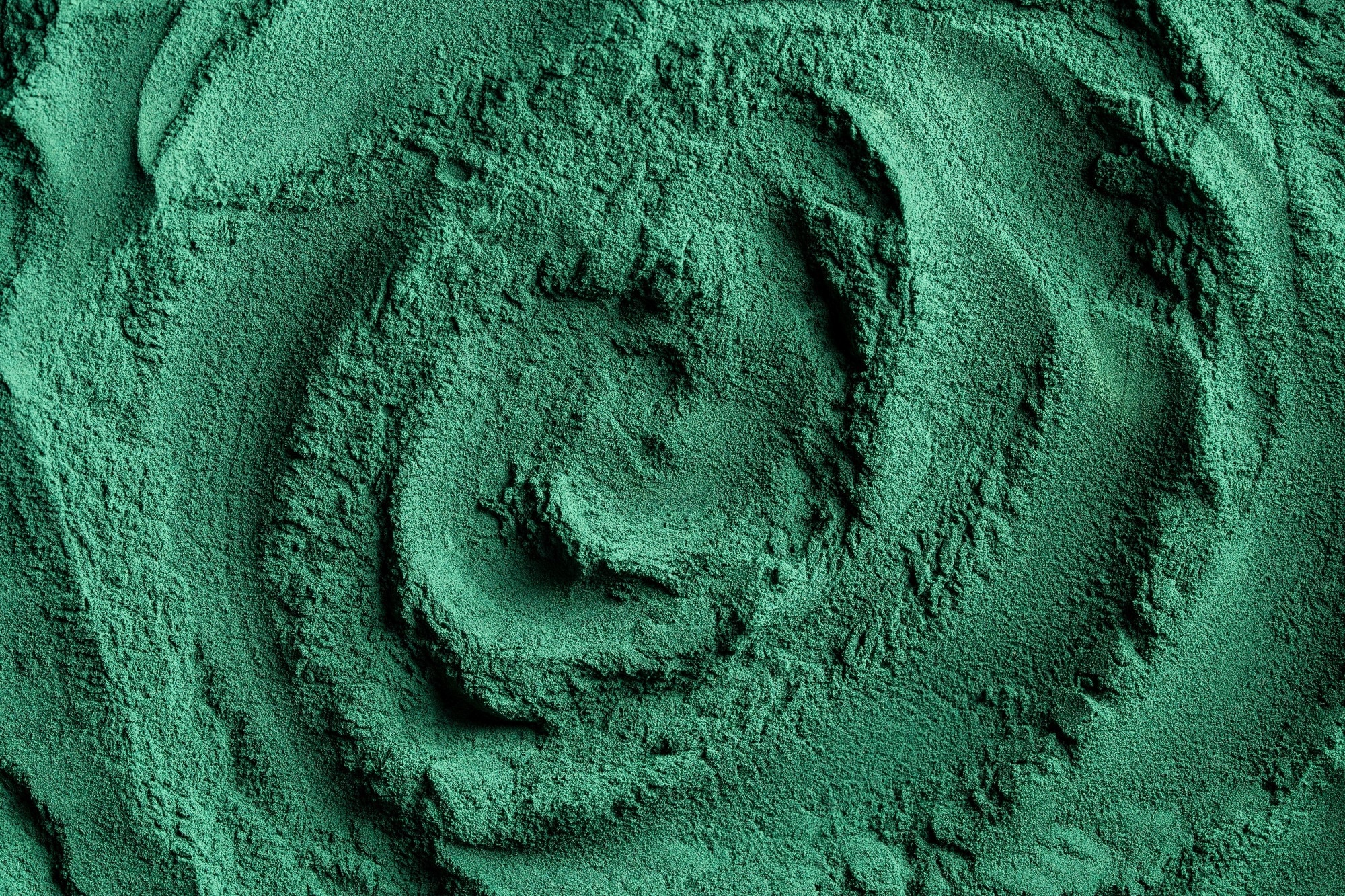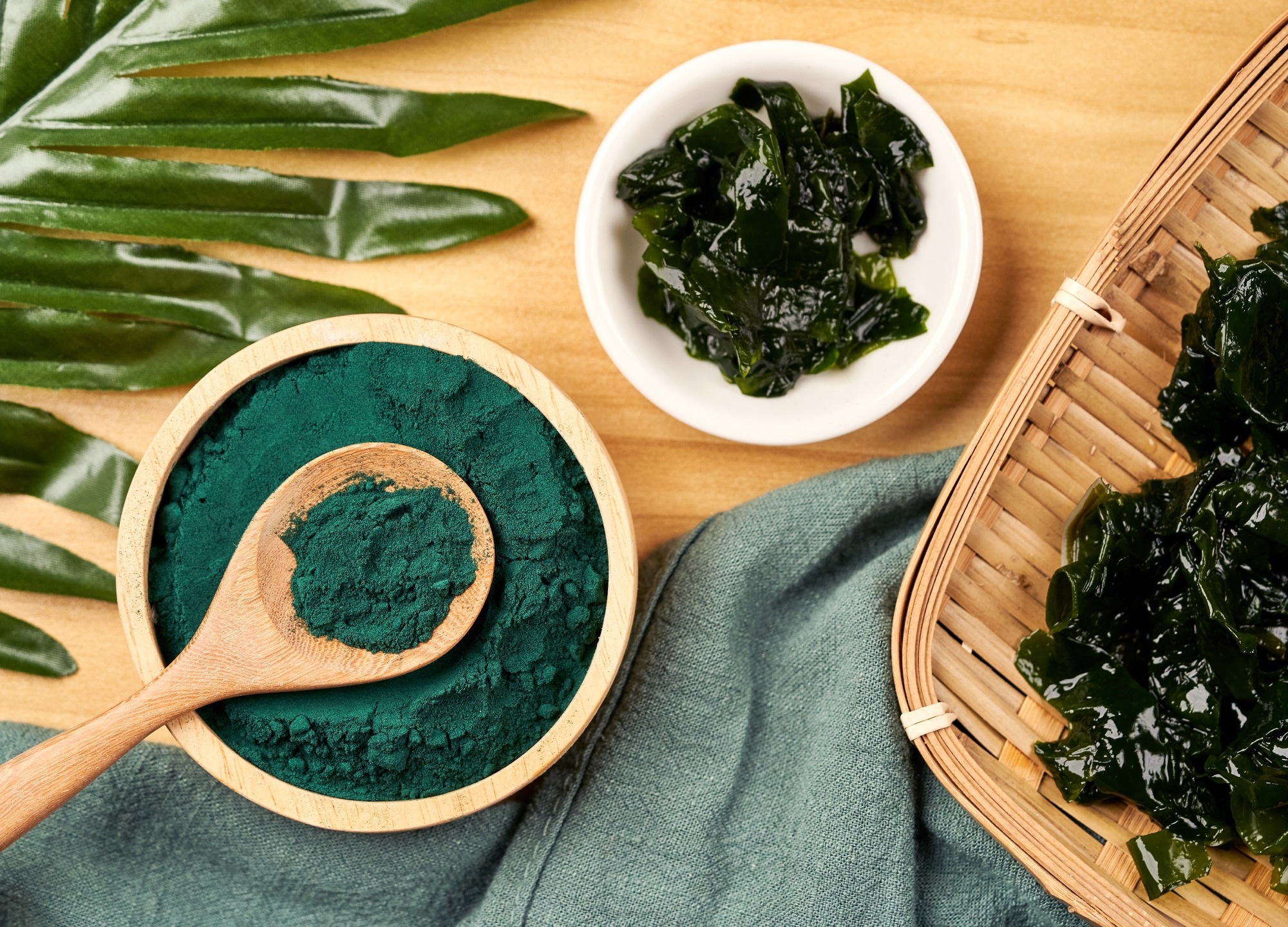Introduction
What is Spirulina?
Bioactive components
Mechanisms of action
Industry and applications
Safety and limitations
Conclusion
References
Further reading
Discover how Spirulina’s unique blend of proteins, pigments, and polyphenols makes it a powerful ally against oxidative stress, inflammation, and cellular aging while offering sustainable nutrition for the future.
 Spirulina, dried biomass derived from cyanobacteria (commonly known as blue-green algae), Arthrospira platensis, Arthrospira fusiformis, and Arthrospira maxima are the main species. Image Credit: OlegD / Shutterstock.com
Spirulina, dried biomass derived from cyanobacteria (commonly known as blue-green algae), Arthrospira platensis, Arthrospira fusiformis, and Arthrospira maxima are the main species. Image Credit: OlegD / Shutterstock.com
Introduction
Spirulina is rich in numerous proteins, phycobiliproteins, carotenoids, and phenolics that deliver potent antioxidant, anti-inflammatory, and collagen-boosting activities. Pre-clinical studies have reported that these molecules quench reactive oxygen species (ROS), upregulate epidermal growth factor (EGF) signaling, and suppress matrix metalloproteinases (MMPs), thereby protecting fibroblasts and keratinocytes from ultraviolet (UV) stress and senescence.1
This article examines the potent antioxidant, anti-inflammatory, and deoxyribonucleic acid (DNA)-protective compounds present within Spirulina to highlight this cyanobacterium as a promising and eco-friendly anti-aging nutraceutical.
What is Spirulina?
Spirulina, which is taxonomically assigned to the filamentous cyanobacterial genus Arthrospira, most commonly A. platensis and A. maxima, is found in alkaline, sun-lit waters and accumulates up to 60% protein by dry weight. Traditionally, Kanembou communities in Lake Chad and Aztec populations located near Lake Texcoco harvested this blue-green biomass as dried cakes, valuing its concentrated nutrition long before modern science examined its merits.
Global awareness of this plant rose after 1967, when the International Association of Applied Microbiology described Spirulina as a “food of the future.” Soon thereafter, the United States Food and Drug Administration (FDA) classified Spirulina as generally regarded as safe (GRAS), which accelerated its commercial cultivation.2
Arthrospira is widely cultivated in open raceway ponds or closed photobioreactors, which exemplifies the resilience of Spirulina to high pH and salinity associated with these methods. Common retail spirulina products include fine spray-dried powders for smoothies and bakery fortification, compressed tablets for convenient dosing, and aqueous or ethanol extracts.
The blue pigment C-phycocyanin (C-PC) isolated from Spirulina can also be used as a natural colorant in confectionery, dairy, and beverage applications. The neutral flavor of spirulina variants facilitates their widespread incorporation into energy bars, soups, and vegan meat substitutes worldwide.2
Bioactive components
Approximately 55-70% of Spirulina's dry weight is protein, which delivers all nine essential amino acids in a form that is up to 90% digestible, making it superior to most plant and animal sources in both concentration and bioavailability. Spirulina also contains bioactive corrinoids that mimic vitamin B12, as well as provitamin A (β-carotene), which the body converts into retinol for vision and immune defense.
The mineral profile of Spirulina is equally dense, with every 100 grams providing 1.4-1.6 g potassium, 0.37-0.40 g magnesium, and 100-170 mg of highly bioavailable iron, all of which are nutrients that are often limited in plant-based diets. Magnesium is an essential cofactor for numerous enzyme reactions, whereas potassium balances fluids and neuromuscular signaling, and pigment-protein complexes provide extra functional benefits.3
Phycocyanin, which accounts for about 20% of Spirulina’s protein content, neutralizes ROS and provides the blue-green color of Spirulina that is highly sought after in clean-label food dyes. Photoprotective carotenoids, particularly zeaxanthin and lutein, protect cells against UV insult.
Methanolic extracts of Spirulina are rich in polyphenols, ranging from 7.8 to 44.5 mg gallic acid equivalents (GAE) per gram, that amplify antioxidant defenses. Balanced macronutrients, trace minerals such as iron and magnesium, as well as a broad spectrum of protective phytochemicals, converge to make Spirulina a compact and eco-efficient reservoir of bioactive nutrients that support immunity, vision, metabolic resilience, cellular longevity, and overall human well-being.3
 Image Credit: bommaval / Shutterstock.com
Image Credit: bommaval / Shutterstock.com
Mechanisms of action
The pigment phycocyanin within Spirulina comprises a chromophore that donates electrons to quench hydroxyl and peroxyl radicals. This redox reaction induces superoxide dismutase (SOD), catalase (CAT), and glutathione peroxidase (GPx) activity, thereby reducing malondialdehyde accumulation and restoring redox balance.4
In cultured macrophages and rodent models, spirulina extracts inhibit cyclooxygenase-2 (COX-2) activity and nuclear factor kappa-light-chain-enhancer of activated B cells (NF-κB) translocation. These antioxidant effects reduce the secretion of interleukin-6 (IL-6) and tumor necrosis factor-alpha (TNF-α) by up to 60%.4
A selenium-rich spirulina protein (Se-SP) stabilizes mitochondrial membranes during ischemia or hypoxia, thereby preventing permeability transition pore opening, preserving membrane potential, and increasing adenosine triphosphate (ATP) synthesis. These effects arise from rebalanced B-cell lymphoma 2 (Bcl-2) family signaling, which favors anti-apoptotic proteins over pro-apoptotic B-cell lymphoma-2-associated X protein (Bax).4
Se-SP also counteracts 8-hydroxy-2′-deoxyguanosine lesions, which limit comet-assayed strand breaks and increase the expression of base-excision repair enzymes like 8-oxoguanine DNA glycosylase. These mechanisms establish Spirulina as a broad-spectrum nutraceutical protector for cellular resilience and wellness.4
Industry and applications
Certified as GRAS by the U.S. FDA, the rich protein, vitamin, and antioxidant pigment content of Spirulina is often incorporated into high-protein pastas, meat analogues, breads, and antioxidant-enriched ice creams in an effort to provide sustainable and nutrition-rich products.
Large-scale cultivation of Spirulina can be completed in closed photobioreactors on non-arable land. This allows manufacturers to generate uniform biomass while reducing the carbon footprint of conventional animal-protein supply chains.1
Cosmetic formulators also utilize the blue pigment C-PC and spirulina polyphenols for anti-aging serums, sunscreens, and solid shampoos. These extracts support fibroblast collagen production, inhibit matrix metalloproteinase activity, and protect keratinocytes from UV-induced apoptosis, thereby reducing the appearance of wrinkles and improving skin elasticity.
The production of Spirulina must be accompanied by careful monitoring of heavy-metal uptake, microbial loads, and batch-to-batch pigment variability. Downstream ultrafiltration or aqueous two-phase extraction is also essential to reach food- or cosmetic-grade purity for C-PC.
Hazard-analysis plans and validated purification protocols are essential for protecting both brand reputation and consumer health. These approaches ensure that spirulina-enriched products deliver vibrant color and proven bioactivity, free from unsafe contaminants.1
Farm Grown Hawaiian Microalgae Supplements - Hawaiian Spirulina & BioAstin Hawaiian Astaxanthin
Safety and limitations
Extensive animal and human data have confirmed that the intake of Spirulina does not lead to any significant adverse effects. However, it is crucial to recognize the immune-modulatory effects of Spirulina, which can exacerbate symptoms in patients diagnosed with autoimmune disorders.5
Commercial producers grow algae in controlled alkaline ponds. However, wild harvests from untreated lakes are at an increased risk of heavy-metal or cyanotoxin contamination, which emphasizes the importance of rigorous sourcing to ensure product safety.
Spirulina is generally considered safe when contaminant-tested and used in appropriate doses. Nevertheless, consumers should verify product purity and seek medical advice if they have immune diseases or rely on spirulina supplementation for vitamin B-12.5
Conclusions
The rich content of phycocyanin, carotenoids, and polyphenols in Spirulina effectively neutralizes ROS, upregulates endogenous antioxidant enzymes, and downregulates pro-inflammatory mediators such as IL-6 and TNF-α. As a result, Spirulina preserves mitochondrial membrane potential, sustains ATP synthesis, and protects DNA.
To confirm the therapeutic potential of Spirulina, long-term, randomized, and placebo-controlled studies comprising diverse populations are crucial. These studies can also clarify optimal dosing regimens and establish long-term safety.
References
- Ramos, S. D. P., Bürck, M., Costa, S. F. F. D., Assis, M., & Braga, A. R. C. (2025). Spirulina as a Key Ingredient in the Evolution of Eco-Friendly Cosmetics. BioTech, 14(2), 41. DOI: 10.3390/biotech14020041, https://www.mdpi.com/2673-6284/14/2/41
- Costa, J. A. V., Freitas, B. C. B., Rosa, G. M., Moraes, L., Morais, M. G., & Mitchell, B. G. (2019). Operational and Economic Aspects of a Spirulina-Based Biorefinery. Bioresource technology, 292, 121946. DOI: 10.1016/j.biortech.2019.121946, https://www.sciencedirect.com/science/article/pii/S0960852419311769?via%3Dihub
- Podgórska-Kryszczuk, I. (2024). Spirulina—An Invaluable Source of Macro-and Micronutrients with Broad Biological Activity and Application Potential. Molecules, 29(22), 5387. DOI: 10.3390/molecules29225387, https://www.mdpi.com/1420-3049/29/22/5387
- Trotta, T., Porro, C., Cianciulli, A., & Panaro, M. A. (2022). Beneficial effects of spirulina consumption on brain health. Nutrients, 14(3), 676. DOI:10.3390/nu14030676, https://www.mdpi.com/2072-6643/14/3/676
- Karkos, P. D., Leong, S. C., Karkos, C. D., Sivaji, N., & Assimakopoulos, D. A. (2011). Spirulina in clinical practice: evidence‐based human applications. Evidence‐based complementary and alternative medicine, 2011(1), 531053.
- DOI: 10.1093/ecam/nen058, https://onlinelibrary.wiley.com/doi/10.1093/ecam/nen058
Further Reading
Last Updated: Jul 7, 2025